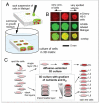Microfluidic 3D cell culture: potential application for tissue-based bioassays
- PMID: 22793034
- PMCID: PMC3909686
- DOI: 10.4155/bio.12.133
Microfluidic 3D cell culture: potential application for tissue-based bioassays
Abstract
Current fundamental investigations of human biology and the development of therapeutic drugs commonly rely on 2D monolayer cell culture systems. However, 2D cell culture systems do not accurately recapitulate the structure, function or physiology of living tissues, nor the highly complex and dynamic 3D environments in vivo. Microfluidic technology can provide microscale complex structures and well-controlled parameters to mimic the in vivo environment of cells. The combination of microfluidic technology with 3D cell culture offers great potential for in vivo-like tissue-based applications, such as the emerging organ-on-a-chip system. This article will review recent advances in the microfluidic technology for 3D cell culture and their biological applications.
Figures







Similar articles
-
Microfluidic systems for stem cell-based neural tissue engineering.Lab Chip. 2016 Jul 5;16(14):2551-71. doi: 10.1039/c6lc00489j. Lab Chip. 2016. PMID: 27296463 Free PMC article. Review.
-
Wnt5a-mediating neurogenesis of human adipose tissue-derived stem cells in a 3D microfluidic cell culture system.Biomaterials. 2011 Oct;32(29):7013-22. doi: 10.1016/j.biomaterials.2011.05.090. Epub 2011 Jun 25. Biomaterials. 2011. PMID: 21705075
-
A pump-free microfluidic 3D perfusion platform for the efficient differentiation of human hepatocyte-like cells.Biotechnol Bioeng. 2017 Oct;114(10):2360-2370. doi: 10.1002/bit.26341. Epub 2017 Jun 27. Biotechnol Bioeng. 2017. PMID: 28542705
-
Microfabrication and microfluidics for tissue engineering: state of the art and future opportunities.Lab Chip. 2004 Apr;4(2):98-103. doi: 10.1039/b314469k. Epub 2004 Mar 10. Lab Chip. 2004. PMID: 15052347 Review.
-
Paper-supported 3D cell culture for tissue-based bioassays.Proc Natl Acad Sci U S A. 2009 Nov 3;106(44):18457-62. doi: 10.1073/pnas.0910666106. Epub 2009 Oct 21. Proc Natl Acad Sci U S A. 2009. PMID: 19846768 Free PMC article.
Cited by
-
Organ-on-a-chip platforms for accelerating the evaluation of nanomedicine.Bioact Mater. 2020 Oct 12;6(4):1012-1027. doi: 10.1016/j.bioactmat.2020.09.022. eCollection 2021 Apr. Bioact Mater. 2020. PMID: 33102943 Free PMC article. Review.
-
Microfluidics for 3D Cell and Tissue Cultures: Microfabricative and Ethical Aspects Updates.Cells. 2022 May 20;11(10):1699. doi: 10.3390/cells11101699. Cells. 2022. PMID: 35626736 Free PMC article. Review.
-
Microfluidic perfusion modulates growth and motor neuron differentiation of stem cell aggregates.Analyst. 2020 Jul 21;145(14):4815-4826. doi: 10.1039/d0an00491j. Epub 2020 Jun 9. Analyst. 2020. PMID: 32515433 Free PMC article.
-
A versatile PDMS/paper hybrid microfluidic platform for sensitive infectious disease diagnosis.Anal Chem. 2014 Aug 5;86(15):7978-86. doi: 10.1021/ac5021694. Epub 2014 Jul 24. Anal Chem. 2014. PMID: 25019330 Free PMC article.
-
Incubator-independent cell-culture perfusion platform for continuous long-term microelectrode array electrophysiology and time-lapse imaging.R Soc Open Sci. 2015 Jun 17;2(6):150031. doi: 10.1098/rsos.150031. eCollection 2015 Jun. R Soc Open Sci. 2015. PMID: 26543581 Free PMC article.
References
-
- Marimuthu M, Kim S. Microfluidic cell coculture methods for understanding cell biology, analyzing bio/pharmaceuticals, and developing tissue constructs. Analytical biochemistry. 2011;413(2):81–89. - PubMed
-
- Elliott NT, Yuan F. A review of three-dimensional in vitro tissue models for drug discovery and transport studies. Journal of pharmaceutical sciences. 2011;100(1):59–74. - PubMed
-
- A fair recent review about tissue bodels, but not specificly related to microfluidics.
-
- Chen SY, Hung PJ, Lee PJ. Microfluidic array for three-dimensional perfusion culture of human mammary epithelial cells. Biomed Microdevices. 2011;13(4):753–758. - PubMed
Publication types
MeSH terms
Grants and funding
LinkOut - more resources
Full Text Sources
Other Literature Sources
